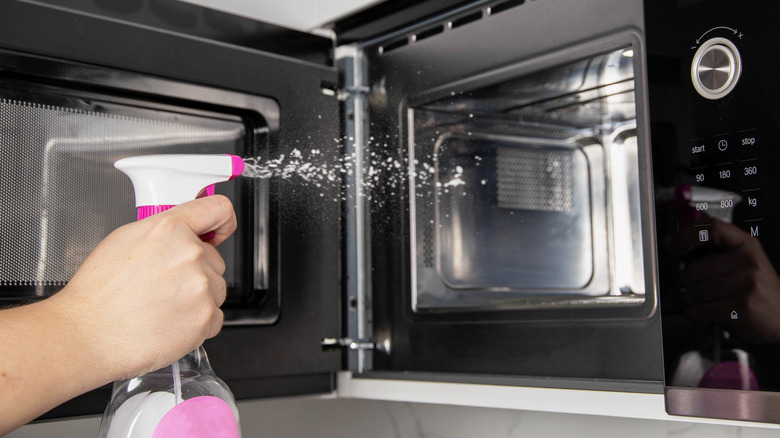Make Your Microwave Good As New With An Ingredient Already In Your Pantry
Microwave splatter covers are technically a thing. I actually own one, but do I ever remember to use it? Of course I don't, nor do I bother to cover my food when I zap it. Since I use my microwave on a regular basis, needless to say, it can get pretty messy in there. Sometimes a quick wipe with a wet sponge does the trick. But for stubborn splatters, it's time to break out the big gun: white vinegar.
Technically, you could use just about any kind of vinegar for this since all vinegar contains acetic acid which is capable of dissolving grease and cooked-on food. However, the main difference between cooking vinegar and cleaning vinegar is that cleaning vinegar tends to cost a lot less. It's also colorless, which is helpful if you're using it on a surface that's likely to stain. It also has an acid level comparable to that of commercial cleaning products.
An easy way to harness your microwave's power to help with the cleaning process is to mix 2 tablespoons of vinegar into a bowl of water and heat it on high (the normal setting) for a minute or two. When the timer goes ding, leave the door closed for another five minutes so the steam can loosen all the gunk. This resting period will allow the liquid to cool enough to where you can dip a sponge in before wiping the microwave inside and out.
You may need to raid the laundry room to disinfect it
Vinegar makes it easy to clean your grimy microwave, but one thing you should be aware of is it's not the best product for sanitizing or disinfecting. While it can protect against some types of bacteria, it's ineffective against others. As it turns out, microwaves are surprisingly germy environments. Some studies indicate the radiation microwaves produce may be sufficient to kill bacteria, but other microorganisms are able to resist the rays and even thrive inside the appliance.
No, you probably aren't going to develop some kind of deadly disease solely on account of an unsanitized microwave. But if you want to make sure the appliance is as germ-free as it is sparkling clean, you might want to clean it out with diluted bleach from time to time. (Don't do this at the same time you're using vinegar, however, since vinegar and bleach combine to produce harmful chlorine gas.) The bleach solution shouldn't be all that strong; just a ¼-teaspoon per cup of water is plenty. Never use undiluted bleach for this purpose as it's strong enough to cause damage and will also create powerful toxic fumes. If you'd prefer to avoid the risk, you can use disinfectant sprays or wipes to sanitize the appliance instead. Again, be very careful when using products containing bleach. If you're not sure all of the microwave's surfaces are free of residual vinegar, err on the side of caution.

